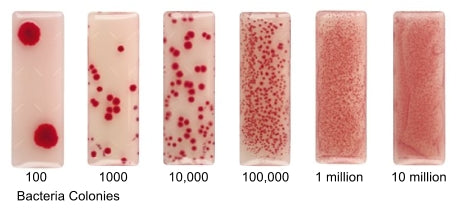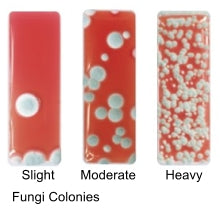Microbial Test Kit, 4 Pack
Because the manufacturer recommends these be shipped between a temperature of 2°C - 40°C (36°F - 104°F) with a travel time of no more than 1 week, only UPS International services are available for our international customers.
DUE TO THE NATURE OF THIS PRODUCT, ALL SALES ARE FINAL, IT MAY NOT BE RETURNED.
Lotioncrafter's Microbial Test Kit is an easy to use testing kit for quality control checking of your cosmetic products. The Nutrient-TTC Agar (yellow side) is general purpose (relatively non-selective) medium, containing two peptones, which will support the growth of a wide variety of organisms. Suitable for cultivation of both aerobes and anaerobes. Rose Bengal Chloramphenicol Agar (pink side) is recommended in Standard Methods for the enumeration of yeasts and molds from food and water. There are four (4) dip slides and 8 sterile swabs included with each kit.
Our Microbial Test Kits are manufactured under aseptic conditions and the agar surfaces contain no toxic ingredients that could be transferred to the products being tested. Each dip slide is supplied with a transparent, shatterproof protective tube. Subsequent contamination is therefore prevented, and the results can be evaluated with the tube sealed, thus avoiding the risk of contamination to the user.
Each kit comes with a color chart to help you interpret the results and, because cosmetic products are thick and often swabbed onto the slides rather than dipped, we provide 8 sterile swabs with each kit!
Benefits
- Simple application
- Fast, safe and easy
- Precise and reliable
- Economical to use
- Can be used on surfaces, semi-solid materials, and liquids
- Separate evaluation of bacteria, yeasts and molds
- Microbiology training is not necessary to interpret the results
Storage and stability
Our Microbial Test Kit tubes should be stored unopened at room temperature (about +20°C/+68°F) and protected from drought and light (simply leaving them in their sturdy, light proof box is a good idea). The slides must not be allowed to freeze. The expiration date is marked on each tube (shelf life is 9-10 months; typically there is about 7-8 months shelf life from the time of manufacture -- each tube has a "Best Before End", printed on the side as BBE: YY-MM-DD. Any unused slide showing microbial growth should be discarded. Temperature fluctuations may result in condensation settling at the bottom of the dip-slide tube. This sterile liquid can simply be disposed of down the sink. The performance and the results of Microbial Test Kit are not affected by this, provided that the media are not visually dehydrated.
How to Use (this information can also be found in the instructions provided in the test kit box):
- The dip-slide is carefully removed from its container without touching the agar surfaces. It is then dipped into thin or aqueous products and held in contact with the sample for 5-10 seconds so both sides of the slide are completely wet.
- If you're testing a cream or lotion, using a sterile swab, dip into your sample and streak the surface of each agar plate.
- Place the slide back in the tube and screw on the top.
- The test slides can be incubated using an incubator and initial results can be examined and enumerated after 24-48 hours for bacteria and 48 and up to 120 hours for yeast and mold. If no incubator is used and the slides are stored at room temperature, you may need to wait up to 5 days for bacteria and up to 7 days for yeast and mold. We say "examine" because you may need to leave it in the incubator (or wherever you have it stored) a bit longer, especially for slow-growing organisms, but you want to get a first look in at that time. If you have organisms that grow quickly, and you leave them for too long, growth will become confluent.
- After incubation, compare the colony density on the agar surface with the included evaluation chart. The results should be evaluated with the tube sealed.
Interpretation of Results
The evaluation chart shows colonies formed on the slides which correspond to different degrees of microbial contamination. The figures are shown in colony forming units per milliliter (cfu/ml) on the included chart.
- Colony growth of incubated samples on both sides of the slide is compared to the pictures in the evaluation chart the picture that most closely resembles the colony density on the agar slide is taken as the test result.
- Bacterial growth - Most bacteria grow to form red colonies, but colorless colonies may also form and must be taken into consideration.
- Yeasts and Molds - It is possible for molds or yeast or a mixture of both to grow on the rose bengal agar.



The Microbial Test kit, 4 pack is final sale, and therefor not eligible for return.











